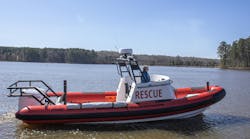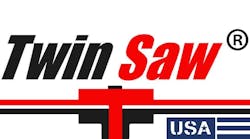Each job required a combination of special skills, equipment and innovative thinking. The results of these incidents included the rescue of four people and one body recovery. The cave-in operation, in particular, blended techniques learned in trench rescue training with procedures used in structural collapse stabilization.
At about 5:30 P.M. on Sept. 22, the West Bloomfield, MI, Fire Department was notified of a "cave-in" accident on Farmington Road. First-arriving companies found workers in a 13-foot-deep excavation. A large section of compact clay soil had sheared off the vertical wall of the excavation project. Working with construction company employees, the West Bloomfield firefighters removed two workers from the hole.
A third worker, however, was partially buried and crushed. Falling soil had driven him onto the large pipe that he had been welding and buried him from mid-torso down. Unprotected vertical dirt walls were on three sides of him. The distance between the two walls running perpendicular to Farmington Road was 26 feet. The wall that had sheared was adjacent to the road and, in fact, was dug right up to the curb. The wall that was parallel to the road was a sloping wall about 50 feet away.
West Bloomfield firefighters closed Farmington Road to traffic and established a pedestrian perimeter shortly after their arrival. They then requested technical rescue assistance from the Pontiac Fire Department, which maintains a Technical Rescue Squad truck and a Collapse Rescue trailer.
Concerns addressed by West Bloomfield and Pontiac fire personnel, in what was to evolve into a two-hour body recovery operation, included:
- Scene control. General area control was established, with police help, by barring traffic, preventing civilian access and providing for media coverage from a safe distance. Rescue area control was established with access limited to assigned personnel.
- Hazards. Utilities, such as overhead wires, underground gas, electric and water lines, as well as the presence of fuel and hazardous material containers, were all evaluated.
At the time of the collapse, welding was being done within the hole. The power source for the welder was on a truck parked on Farmington Road. This unit was readily accessible and was shut off and secured. The "lip" area was protected with ground pads from the PFD collapse trailer.
Unsecured trenches and excavations are extremely dangerous areas because of their potential for collapse (or secondary collapse). Well-intending rescuers can cause soil to collapse when digging in unprotected excavations. This not only places them at risk but has the potential to further injure the people they are attempting to help.
Wall Stabilization
Shorform panels with pre-attached two-by-12-inch uprights were placed into the hole to begin the shoring operation. Because of the width of the excavation, a plan was developed to use two panels pinned back by the bucket of a backhoe already in the excavation.
This temporary bracing was planned to be used exclusively for "safety shoring" to protect shoring personnel who had entered the hole to erect a raker (diagonal) shoring system. This system consisted of the safety shoring, panels, uprights and four-by-six-inch timbers. Small void areas behind the panels were backfilled with airbags, four-by-four-inch timbers and dirt. (A trench box was requested but was not available.)
Firefighters reached the partially buried victim from within the confines of the emergency shoring system. Digging began with folding trenching shovels and concluded with firefighters brushing and moving dirt with their hands. Because the victim had suffered a crushing head injury and had no vital signs, the rescuers ruled out any resuscitation attempt. After about 20 minutes in the hole, constructing shores and freeing the victim from entrapment, the first entry team exited the space.
The second entry team placed the victim in a body bag and then secured him into a stokes basket. A fixed ladder slide technique was used to remove the body from the 13-foot-deep excavation. This technique required the use of a 24-foot fire service ladder, ropes, webbing, carabiners, a stokes basket and manpower.
Lessons Learned
- The construction of raker shores for emergency scenes (be they structural or excavation collapse incidents) will usually require working in exposed areas. These exposures clearly put an element of risk into the operation. Officers faced with tactical decisions need to understand this fact and to use it in the risk/gain analysis.
In this case, once that tactical decision was made, we attempted to limit the exposure time of rescuers by having them stand clear of potential collapse areas. During the assembly of shoring systems, exposure to these areas can be kept to a minimum by requiring shoring team members to move out of the potential collapse areas whenever they are not placing or nailing shoring components. (Certain areas of large extrications can actually be out of collapse zones due either to their distance from vertical walls or proximity to sloping walls.) Additionally, a lot of the measurements can be taken from outside the hole. With a basic set of measurements, a skilled cutting crew can cut lengths, angles and notches in timbers before any rescuers enter the space.
- Make a quick sketch of the shoring system you have in mind. Share that sketch with the shoring as well as the cutting teams. This "blueprint" can go a long way in assuring that what was designed is what is getting built. We suggest contacting a professional engineer or an Occupational Safety & Health Administration (OSHA) representative to work out the details needed for this type of excavation rescue operation prior to responding to an emergency.
- Connections (points of contact) are critical in any timber shoring operations. Clean cuts, accurate angles and the use of "field" fabricated (plywood) gusset plates and cleats con help maintain higher levels of strength for timber shoring systems.
- A raker shoring system (see drawing on page 34) adds strength and stability to timber shores. At this incident, such a system was not developed. The victim was, in fact, dug out after safety shoring placement and a simple raker shore was established.
- Assess the hazards and systematically put mitigation methods into place. Atmospheric hazards must not be overlooked. They must either be ruled out through air monitoring or mitigated through self-contained breathing apparatus (SCBA) or proper ventilation techniques.
- Body recovery can be a difficult operation. While we must take our time and minimize all risks to our personnel at these operations, we must keep in mind that we are still removing the remains of a human being.
The removal must be done with the dignity that a fallen worker and fellow human deserves. At the scene of this excavation accident, several friends and two brothers, who also worked for the company, were present during the removal. While it is good practice to coax relatives away from the scene and to refer them to counselors or clergy, their thoughts and memories must be considered.
In summary, while most of the body recovery operation was typical of the trench rescue training that we had done, the width of the hole made horizontal (trench) shoring impossible. We understand that other options (such as using trench boxes and cutting the walls back to safe angles) are available for this type of recovery operation. In fact, some were discussed at the scene and, in hindsight, may have been appropriate alternatives to the method we chose to secure the excavation.
More important than any tactical choices made that day is the fact that construction, in both elevated and below-grade areas, occurs daily throughout the country. Fire departments respond to these sites when accidents occur. Taxpayers, city administrators and other "customers" expect us to deliver these services. Traditional firefighting equipment, training and experience, however, do not adequately prepare us for these operations.
Author's note: A peer review of this article indicated that the use of raker shores, in general, is a point of controversy within the rescue community. Many of the instructors surveyed teach raker shore use only for building collapses; others include it in building and excavation training. One instructor advocates not using raker shores for any emergency operation. Nearly all of the instructors surveyed said they are concerned with rescuer exposure during raker shore construction and the relatively high level of carpentry proficiency that rakers require.
Ron Zawlocki, a career firefighter for over 20 years, is a captain in the Pontiac, MI, Fire Department, assigned to Station 1.







